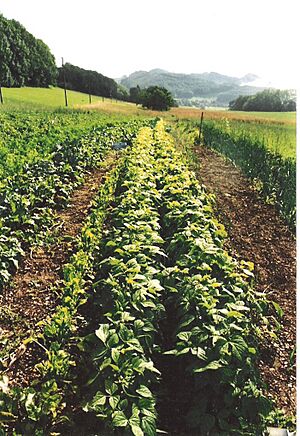Hauenstein-Ifenthal facts for kids
Quick facts for kids
Hauenstein-Ifenthal
|
||
|---|---|---|

Ifenthal village
|
||
|
||
| Country | Switzerland | |
| Canton | Solothurn | |
| District | Gösgen | |
| Area | ||
| • Total | 5.35 km2 (2.07 sq mi) | |
| Elevation | 675 m (2,215 ft) | |
| Population
(Dec 2020 )
|
||
| • Total | 306 | |
| • Density | 57.20/km2 (148.1/sq mi) | |
| Postal code |
4633
|
|
| Surrounded by | Eptingen (BL), Hägendorf, Läufelfingen (BL), Rickenbach, Trimbach, Wangen bei Olten, Wisen | |
Hauenstein-Ifenthal is a small town, also called a municipality, located in Switzerland. It's part of the Gösgen district in the canton of Solothurn. This charming area is known for its beautiful natural surroundings.
Contents
A Look Back in Time
The village of Ifenthal was first mentioned in old writings way back in 1189. It was called Ifental then. Hauenstein was mentioned a bit later, in 1260, and was known as Horwen. These names show how long people have lived in this area!
Exploring the Geography
Hauenstein-Ifenthal covers an area of about 5.35 square kilometers (which is about 2.07 square miles). Imagine a place where half the land is used for farming, like fields and pastures! That's 50.7% of the area.
A big part of the municipality, about 40.2%, is covered by forests. The rest of the land, about 8%, has buildings and roads. A tiny bit, 0.4%, is land that can't be used for anything.
The municipality includes two main villages: Hauenstein and Ifenthal. You'll also find many scattered houses around. There's even talk about Hauenstein-Ifenthal possibly joining with nearby towns like Trimbach, Wisen, and Olten in the future to form a new, bigger municipality.
What the Coat of Arms Means
The blazon (description) of Hauenstein-Ifenthal's municipal coat of arms is: Gules a lion passant Or on a base Vert. This means the coat of arms shows a golden lion walking across a red background, with a green base underneath it. A coat of arms is like a special symbol or logo for the town.
Who Lives Here?
Hauenstein-Ifenthal has a population of 306 people. Most people in the municipality speak German, which is 98.5% of the population. A few people also speak Romansh or Spanish.
In 2000, about 37.4% of the people living in Hauenstein-Ifenthal were born there. Many others were born in the same canton (29.1%) or elsewhere in Switzerland (26%). Only a small number, 3.8%, were born outside Switzerland.
The age groups in Hauenstein-Ifenthal in 2000 were:
- Children (0-6 years old): 9.8%
- Teenagers (7-19 years old): 20.4%
- Young Adults (20-24 years old): 6.8%
- Adults (25-44 years old): 27.2%
- Older Adults (45-64 years old): 23.8%
- Seniors (65-79 years old): 7.9%
- Very Seniors (over 80 years old): 4.2%
This shows a good mix of different age groups living in the town.
The historical population is shown in the chart below:

How People Work and Live
In 2010, the unemployment rate in Hauenstein-Ifenthal was very low, at only 1.1%. This means almost everyone who wanted a job had one!
Many people work in the primary economic sector, which includes farming. There were 40 people working in this area, with 15 businesses. A few people work in the secondary sector, like construction. The largest number of people, 53, work in the tertiary sector, which includes jobs like working in hotels, restaurants, or education.
About 138 residents of the municipality have jobs. Many people who live in Hauenstein-Ifenthal travel to other towns for work. In 2000, 95 workers left the municipality for their jobs, while only 21 came into the municipality to work. This means more people leave for work than come in.
For getting to work, 15.2% of people used public transportation, and 60.1% used a private car.
Religious Life
Based on information from 2000, most people in Hauenstein-Ifenthal are Roman Catholic, making up 59.2% of the population. Another 23% belong to the Swiss Reformed Church. A small number of people belong to other Christian churches. About 12.45% of the population said they didn't belong to any church, or were agnostic or atheist.
Learning and Education
Education is important in Hauenstein-Ifenthal. About 41.5% of the population has finished upper secondary education, which is like high school. Also, 12.1% have gone on to get higher education, either from a university or a Fachhochschule (a type of professional university).
In 2000, 29 students from Hauenstein-Ifenthal went to schools outside the municipality.
See also
 In Spanish: Hauenstein-Ifenthal para niños
In Spanish: Hauenstein-Ifenthal para niños






